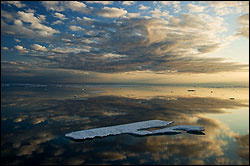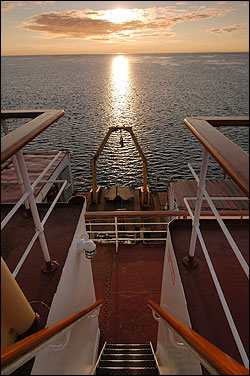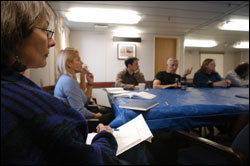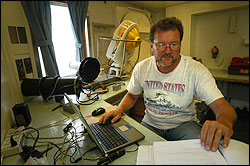Please note: You are viewing
the unstyled version of this website. Either your browser does not support CSS
(cascading style sheets) or it has been disabled. Skip
navigation.
Chris LinderAugust 3, 2005
My alarm jarred me awake what seemed like only minutes later. I didn't want to miss the first science station of the cruise. Chief Technician Doug Sieberg from the Institute of Ocean Sciences directed the operation. Our objective was to confirm that the CTD and software were working properly. We will be using the CTD to measure the water column from the surface to the bottom at strategic locations (science stations). In addition to the data the CTD collects (temperature, salinity, and depth), the Institute of Ocean Sciences team will be analyzing the water collected in the Niskin bottles for a wide variety of different substances, including oxygen, salinity, alkalinity, freons, nutrients, chlorophyll, ammonium, and bacteria. As the cruise progresses I will discuss how each of these analyses plays an important part in understanding the oceanography of the Arctic. Doug and Chief Scientist Sarah Zimmermann were all smiles when the test cast worked without a hitch. This afternoon, while a cold sleety rain pelted the ship, a meeting was held to go over the details of the deck work for recovering and redeploying the six mooring systems and six buoys. Mooring recoveries and deployments can take several hours and involve moving heavy anchors and instruments. It's important that everyone understands the procedure so that the instruments are deployed safely. As I type this dispatch we are making our way through a thick fog to the site of the CABOS (Canadian Basin Observing System) mooring--tomorrow morning the first recovery will get underway... if the ice conditions are favorable. Chief Scientist Sarah Zimmermann has been watching the ice charts closely, and suspects that tomorrow might be a waiting game. "We'll just have to see how it is out there, we are on the edge of the thick ice and may have to wait for some big pans of ice to pass..." Last updated: October 7, 2019 | ||||||||||||||||||||||
Copyright ©2007 Woods Hole Oceanographic Institution, All Rights Reserved, Privacy Policy. | ||||||||||||||||||||||






